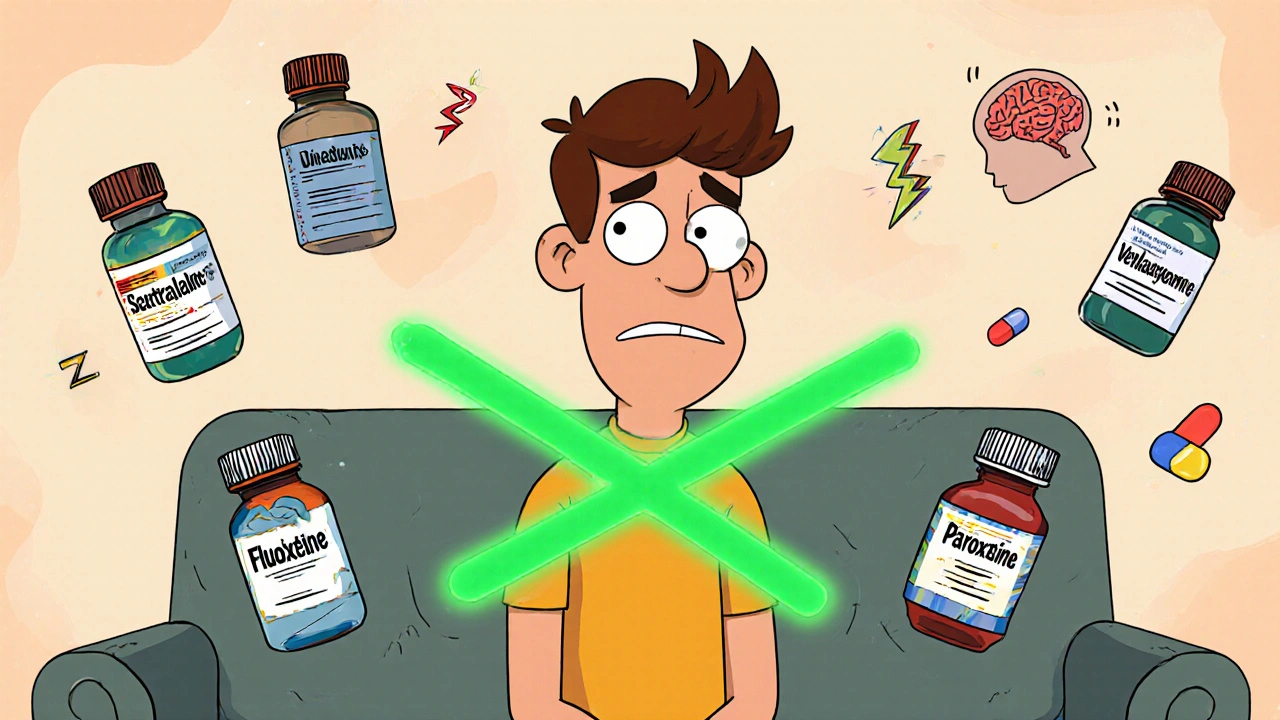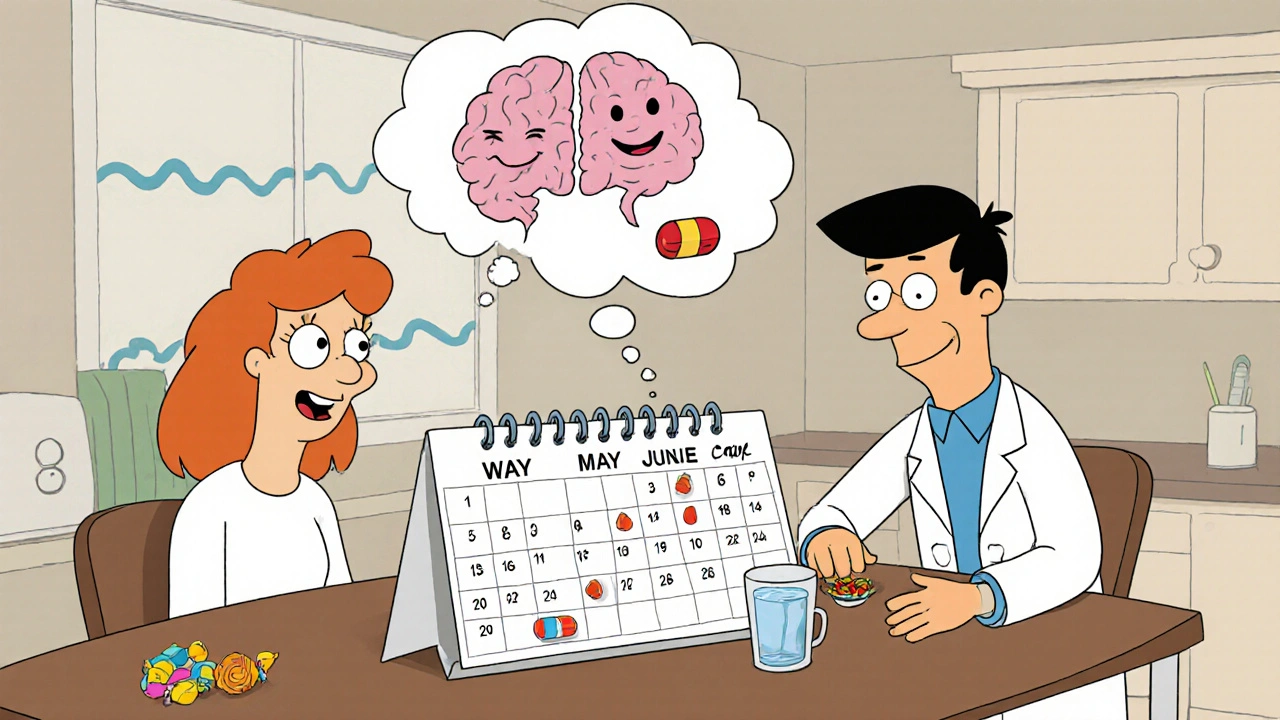
Antidepressant Switching Calculator
Important: This tool provides general guidance only. Always consult your doctor before switching medications. Never stop or change doses without medical supervision.
Recommended Transition Method
Switching antidepressants isn’t something most people plan for. It usually happens because the current medication isn’t working, or the side effects are too hard to live with. Maybe your sleep has gotten worse, or you’re struggling with sexual dysfunction, weight gain, or constant dizziness. You’re not alone - about 30 to 50% of people on antidepressants eventually need to switch. The good news? You can do it safely. But it’s not as simple as stopping one pill and starting another. How you make the switch makes all the difference in how you feel during and after the transition.
Why Switching Antidepressants Can Be Tricky
Antidepressants don’t just change your mood - they change how your brain handles chemicals like serotonin, norepinephrine, and dopamine. When you’ve been taking one for weeks or months, your brain adapts. Suddenly removing it, or adding a new one too fast, can throw your system into chaos. That’s when withdrawal symptoms kick in.
These aren’t just "feeling down" - they’re physical. Dizziness hits 28% of people. Nausea? 24%. Headaches? 22%. Some even feel electric shock-like sensations in their head - called "brain zaps" - especially when switching off paroxetine or venlafaxine. These symptoms usually show up within a day or two after reducing the dose. That’s different from depression coming back, which takes weeks. If you feel better within hours of taking your old pill again, it’s withdrawal, not relapse.
And then there’s serotonin syndrome. It’s rare, but dangerous. It happens when too much serotonin builds up - usually when switching between two antidepressants that both affect serotonin, like SSRIs and SNRIs. Symptoms range from mild (shaking, sweating, restlessness) to life-threatening (high fever, rigid muscles, fast heartbeat). The risk is highest when switching from fluoxetine to another medication because fluoxetine sticks around in your body for weeks. That’s why you can’t just swap it out quickly.
The Four Ways to Switch - And Which One Works Best
There are four main methods doctors use, and not all are created equal.
- Direct switch: Stop the old one, start the new one the next day. This works for some people - especially if switching between similar drugs like sertraline to escitalopram. But it’s risky if the old drug has a short half-life, like paroxetine. Withdrawal can hit hard and fast.
- Taper and switch: Stop the old medication completely, wait a few days, then start the new one. This is safer than a direct switch but still leaves a gap where withdrawal symptoms can flare.
- Taper and switch with washout: Stop the old drug, wait weeks before starting the new one. This is mandatory when switching from an MAOI (like phenelzine) to anything else - you need at least two weeks, or five if you were on fluoxetine. Skipping this can cause a dangerous spike in blood pressure.
- Cross-taper: This is the gold standard. You slowly reduce the old medication while slowly increasing the new one at the same time. The overlap lasts about two weeks. Studies show this cuts withdrawal symptoms by 42% compared to direct switches. It’s especially helpful when moving between SSRIs or SNRIs.
Most experts now recommend cross-tapering as the default approach. It gives your brain time to adjust without crashing. For example, if you’re switching from sertraline to venlafaxine, your doctor might reduce sertraline by 25% every 3-4 days while increasing venlafaxine by the same amount. By day 14, you’re off the old one and fully on the new one.
Medications That Require Extra Caution
Not all antidepressants are equal when it comes to switching. Some are easier. Others? Not so much.
Fluoxetine (Prozac) is the outlier. It has a half-life of 4 to 6 days, and its active metabolite, norfluoxetine, lasts up to 15 days. That means even after you stop taking it, your body is still getting doses for weeks. If you try to start an MAOI or tricyclic antidepressant too soon, you risk serotonin syndrome. You need at least five weeks of no fluoxetine before switching to these drugs.
Paroxetine (Paxil) and venlafaxine (Effexor) are the worst for withdrawal. They leave your system fast - sometimes within 24 hours. That’s why people on these often get brain zaps, dizziness, and rebound anxiety. A slow cross-taper is essential. Some patients even use liquid formulations to make tiny dose reductions, sometimes over 3 to 6 months.
Vortioxetine (Trintellix) and duloxetine (Cymbalta) also have complex effects on serotonin and can interact with other antidepressants. Switching off them requires careful planning. Agomelatine is simpler - it only has one major interaction, with fluvoxamine.
And don’t forget tricyclics like amitriptyline. If you’ve been on fluoxetine, your body can’t break down tricyclics properly. That means even a normal dose could build up to toxic levels in your blood. Doctors start these at very low doses and move slowly.

What to Do During the Switch
During the transition, your body is adjusting. You’re not broken. You’re healing. Here’s what helps:
- Eat with your meds. Taking antidepressants on an empty stomach makes nausea worse. Food can reduce GI side effects by about 35%.
- Small, frequent meals. If your stomach is upset, big meals make it worse. Try five smaller meals instead of three big ones.
- Suck on sugar-free hard candy. It helps with nausea and dry mouth - two common side effects of new antidepressants.
- Drink water. Dehydration makes dizziness and fatigue worse. Aim for 1.5 to 2 liters a day.
- Don’t panic about brain zaps. They’re scary, but not dangerous. They usually fade within days to weeks. If they’re constant or severe, talk to your doctor - you might need to slow down the taper.
- Track your symptoms. Keep a simple journal: mood, sleep, nausea, dizziness, energy. It helps your doctor see patterns and adjust your plan.
Some people find temporary help with over-the-counter options. Hydroxyzine (an antihistamine) can ease anxiety during withdrawal. Melatonin might help with sleep. But don’t self-medicate - always check with your doctor first.
When to Call Your Doctor
Most side effects fade. But some need immediate attention.
Call your doctor right away if you experience:
- High fever, stiff muscles, or confusion - signs of serotonin syndrome
- Thoughts of self-harm or suicide - especially in the first few weeks on a new medication
- Severe dizziness, chest pain, or rapid heartbeat
- Symptoms that get worse instead of better after a week
Also, don’t skip follow-ups. Most guidelines say you should see your doctor within two weeks of starting the new antidepressant. If you’re under 25 or have a history of suicidal thoughts, check in after one week.

What Research Says About Success
A 2022 UK study called MiND found that when patients were clearly told what withdrawal symptoms to expect, they were 37% less likely to quit the switch early. Knowing that brain zaps are normal - and temporary - reduces fear. Fear makes people stop treatment. Education keeps them going.
Another study showed that cross-tapering over 14 days with 25% reductions every 3-4 days led to the best outcomes. People felt better faster, with fewer side effects.
And now, there’s emerging tech. Pharmacogenetic tests like GeneSight analyze your genes to predict how you’ll respond to certain antidepressants. In a 2022 trial, people who used this test had 28% higher remission rates. But it’s expensive - around $400 out-of-pocket in the U.S. - and not yet widely covered by insurance in Australia.
Even more promising? Early trials using ultra-low-dose naltrexone to reduce withdrawal symptoms. In phase 2 studies, it cut discontinuation symptoms by a third. It’s not available yet, but it’s a sign that better, gentler switching methods are on the horizon.
It’s Not Just About the Pill - It’s About You
Switching antidepressants isn’t a technical fix. It’s a personal decision. Your doctor might suggest a change, but you’re the one living with the side effects. That’s why shared decision-making matters. You should be asked: What’s bothering you most? What are you willing to tolerate? What are your goals?
Some people want to get off antidepressants entirely. Others just want to feel like themselves again. Some are fine with weight gain but can’t handle sexual side effects. Others need to avoid any risk of dizziness because they drive for work. Your preferences aren’t optional - they’re essential.
And if you’ve tried one antidepressant and it didn’t work? That doesn’t mean you’ll fail with the next. Only about 30% of people respond to the first one. But 70% respond to the second or third. You’re not broken. You’re still searching.
Switching isn’t a failure. It’s part of finding what works for you.
Can I switch antidepressants on my own?
No. Switching antidepressants without medical supervision can be dangerous. Stopping suddenly can cause severe withdrawal symptoms like brain zaps, seizures, or serotonin syndrome. Even if you feel fine, your brain chemistry needs time to adjust. Always work with your doctor to create a safe, personalized plan.
How long do withdrawal symptoms last after switching?
Most withdrawal symptoms last between 1 and 4 weeks, depending on the medication. For drugs with short half-lives like paroxetine or venlafaxine, symptoms can start within 24 hours and peak around day 3. For fluoxetine, symptoms may not appear for weeks. With a proper cross-taper, symptoms are usually mild and fade within two weeks. If they last longer than a month or get worse, contact your doctor.
Will I feel worse before I feel better?
It’s common to feel a temporary dip in mood or energy during the switch, especially in the first 10-14 days. This is often due to withdrawal, not relapse. The new medication hasn’t had time to build up in your system yet. Most people start to feel improvement after 2-4 weeks on the new drug. If your depression symptoms return or worsen after four weeks, your doctor may need to adjust the dose or try another option.
Is it safe to switch from an SSRI to an SNRI?
Yes, but it requires a cross-taper. Both SSRIs and SNRIs affect serotonin, so switching directly can increase the risk of serotonin syndrome. A gradual overlap - reducing the SSRI while slowly increasing the SNRI - is the safest approach. Your doctor will likely recommend a 10-14 day transition period with careful monitoring.
What if the new antidepressant doesn’t work?
It’s not unusual. About 30% of people don’t respond to the first antidepressant they try, and another 20% don’t respond to the second. If the new medication doesn’t help after 6-8 weeks at the right dose, your doctor may suggest another switch, add-on therapy (like therapy or low-dose lithium), or explore non-medication options like TMS or ketamine therapy. Don’t give up - finding the right treatment often takes time and patience.
Switching antidepressants is a journey - not a one-time fix. It takes time, patience, and the right support. You’re not alone in this. Thousands of people go through it every year. With the right plan, you can move from one medication to the next without falling apart. The goal isn’t just to stop side effects - it’s to find a treatment that lets you live your life again.




sharicka holloway
November 28, 2025Switching meds is brutal, but knowing what to expect makes all the difference. I went from sertraline to venlafaxine with a cross-taper over six weeks. Brain zaps? Yeah. Dizziness? Constant. But I kept a journal, ate small meals, and stuck to the plan. It wasn’t easy, but I didn’t quit. You’re not failing-you’re adjusting.
Emma louise
November 29, 2025Wow. So we’re supposed to believe Big Pharma’s 14-day cross-taper gospel now? Next they’ll tell us to meditate and drink green juice while we’re having brain zaps. I switched cold turkey twice. Survived. Got better. Maybe the system’s broken, not me.
Aishwarya Sivaraj
November 29, 2025I switched from fluoxetine to vortioxetine in India with my doctor's guidance. Took 8 weeks. The worst part was the nausea. I ate ginger tea and rice every day. No fancy tricks. Just patience. People think this is weakness. It's not. It's courage. You're fighting your own chemistry.
Alex Hess
November 30, 2025This article reads like a pharmaceutical brochure. Cross-tapering? Please. Most doctors don’t even know what half-life means. I got prescribed two SSRIs at once because my PCP was ‘busy.’ Two weeks later I was in the ER. This isn’t medicine-it’s guesswork with a clipboard.
Jebari Lewis
December 1, 2025While the cross-taper protocol is statistically superior, the underlying assumption-that all patients have equal access to consistent medical supervision-is flawed. In rural America, many patients are forced into direct switches due to insurance delays, provider shortages, or transportation barriers. The literature rarely accounts for socioeconomic variables. A 25% reduction every 3–4 days assumes weekly follow-ups, which are inaccessible to 40% of low-income patients. We need structural solutions, not just pharmacological ones.
Allison Turner
December 2, 2025Why do people make this so complicated? Just stop the old one. Start the new one. If you feel bad, you’re weak. I’ve done it three times. No journal. No candy. No ‘brain zaps’-just grit. Stop overthinking it.
Darrel Smith
December 4, 2025Let me tell you something. My cousin switched from Prozac to Wellbutrin. He didn’t taper. He didn’t listen to anyone. He just stopped. Three days later he was in the hospital with seizures. They said it was serotonin syndrome. He’s lucky he’s alive. People think they’re smart, but they’re just reckless. This isn’t a video game. You don’t respawn when you die.
Iives Perl
December 5, 2025Brain zaps? Nah. That’s the government testing the neural interface. They’re syncing your meds to the satellite network. You think it’s withdrawal? It’s surveillance. 🤫📡
steve stofelano, jr.
December 7, 2025It is imperative to underscore that the cross-tapering methodology, as articulated in the 2022 UK MiND study, represents the most empirically validated approach to antidepressant transition. The statistical reduction in discontinuation symptoms-42%-is not merely a clinical observation; it is a paradigm shift in therapeutic practice. One must not underestimate the importance of physician-guided titration, particularly in light of the pharmacokinetic complexities inherent in serotonergic agents.
Aishwarya Sivaraj
December 9, 2025Also, GeneSight test? In India, we can't even afford a regular blood test. My doctor just asked what side effects I had and guessed. It worked. Sometimes the simplest solution is the most human one. No genes needed. Just listening.
sharicka holloway
December 9, 2025That’s exactly why I started a free peer-support group for people switching meds. We share tips, dosing schedules, even where to get cheap liquid sertraline. No doctors, no ads, just real people. If you’re scared, you’re not alone. We’ve all been there.
Jauregui Goudy
December 10, 2025I was on paroxetine for five years. Stopped cold turkey once. Worst week of my life. Tremors. Sweating. Felt like my bones were vibrating. Then I did a 12-week cross-taper with escitalopram. Zero brain zaps. Zero panic. I cried when I realized I could sleep through the night without dreaming about falling. This isn’t magic. It’s science. And you deserve to feel like yourself again.